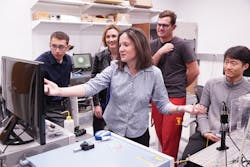Faces in Photonics: Andrea Armani of the University of Southern California
Editor's note: Listen to our podcast interview with Andrea Armani below, which we released on February 18, 2025.
The Faces in Photonics series spotlights experts from around the world whose work is reshaping the growing photonics community.
Here, we feature Andrea Armani of the University of Southern California (Los Angeles, CA), where she is vice dean for New Initiatives, the Irani Chair of Chemical Engineering and Materials Science, and a professor of Chemical Engineering and Materials Science in the Viterbi School of Engineering. She also leads a research lab in the Viterbi School.
Justine Murphy: What attracted you to photonics?
Andrea Armani: My amazing mentor for my undergrad thesis at the University of Chicago, David Grier (now at NYU). As a classic physics department, UChicago did not offer optics or lasers courses. However, he was incredibly patient teaching me about lasers, free-space alignment, optical tweezers and their potential applications in biology, and automated data analysis of videos. Essentially, in his lab, I learned about “convergent research” before it had the fancy name, and he truly catalyzed my interest in the entire field.
JM: What do you enjoy about the industry, and what do you find challenging?
AA: It never gets boring! Like a firework that shoots into the sky and then bursts into hundreds and thousands of streams, every discovery leads to hundreds and thousands more. The challenge is that I joined the show after it started. This means that I’m a perpetual student—continuously trying to catch up on what came before I started, while paying attention to what is currently happening.
JM: What are you working on now?
AA: So many things. My group combines chemistry, electrical engineering, materials science, and physics to develop photonics-based solutions to biomedical and quantum-based challenges. And yes, I put everything in alphabetical order—I don’t have favorites!
In this context, we are making new nonlinear optical materials and new integrated photonic devices and also building new optical systems to advance imaging and diagnostics. We are also collaborating with biologists, oncologists, and neuroscientists to actually test our materials and systems and use them to advance their research.
The best feeling is when something you’ve discovered shoots out of your lab altogether, becoming a thousand streams of light.
About the Author
Justine Murphy
Multimedia Director, Digital Infrastructure
Justine Murphy is the multimedia director for Endeavor Business Media's Digital Infrastructure Group. She is a multiple award-winning writer and editor with more 20 years of experience in newspaper publishing as well as public relations, marketing, and communications. For nearly 10 years, she has covered all facets of the optics and photonics industry as an editor, writer, web news anchor, and podcast host for an internationally reaching magazine publishing company. Her work has earned accolades from the New England Press Association as well as the SIIA/Jesse H. Neal Awards. She received a B.A. from the Massachusetts College of Liberal Arts.


